Milwaukee 5196 Handleiding
Milwaukee
Slijpmachine
5196
Bekijk gratis de handleiding van Milwaukee 5196 (20 pagina’s), behorend tot de categorie Slijpmachine. Deze gids werd als nuttig beoordeeld door 77 mensen en kreeg gemiddeld 5.0 sterren uit 39 reviews. Heb je een vraag over Milwaukee 5196 of wil je andere gebruikers van dit product iets vragen? Stel een vraag
Pagina 1/20

Cat. No. / No de cat.
5192, 5194, 5196
HEAVY-DUTY DIE GRINDERS
EXTRA ROBUSTE RECTIFIEUSES POUR MATRICES
HEAVY DUTY RECTIFICADOR DE MATRICES
OPERATOR'S MANUAL
MANUEL de L'UTILISATEUR
MANUAL del OPERADOR
WARNING To reduce the risk of injury, user must read and understand operator's manual.
AVERTISSEMENT An de réduire le risque de blessures, l'utilisateur doit lire et bien
comprendre le manuel.
ADVERTENCIA Para reducir el riesgo de lesiones, el usuario debe leer y entender el manual.

2
GENERAL POWER TOOL
SAFETY WARNINGS
WARNING
Read all safety warnings, instruc-
tions, illustrations and specica-
tions provided with this power tool. Failure to
follow all instructions listed below may result in
electric shock, re and/or serious injury. Save all
warnings and instructions for future reference.
The term "power tool" in the warnings refers to your
mains-operated (corded) power tool or battery-oper-
ated (cordless) power tool.
WORK AREA SAFETY
• Keep work area clean and well lit. Cluttered or dark
areas invite accidents.
• Do not operate power tools in explosive atmo-
spheres, such as in the presence of ammable
liquids, gases or dust. Power tools create sparks
which may ignite the dust or fumes.
•
Keep children and bystanders away while operating
a power tool. Distractions can cause you to lose control.
ELECTRICAL SAFETY
• Power tool plugs must match the outlet. Never
modify the plug in any way. Do not use any adapter
plugs with earthed (grounded) power tools. Un-
modied plugs and matching outlets will reduce risk
of electric shock.
• Avoid body contact with earthed or grounded
surfaces, such as pipes, radiators, ranges and
refrigerators. There is an increased risk of electric
shock if your body is earthed or grounded.
• Do not expose power tools to rain or wet condi-
tions. Water entering a power tool will increase the
risk of electric shock.
• Do not abuse the cord. Never use the cord for car-
rying, pulling or unplugging the power tool. Keep
cord away from heat, oil, sharp edges or moving
parts. Damaged or entangled cords increase the risk
of electric shock.
• When operating a power tool outdoors, use an ex-
tension cord suitable for outdoor use. Use of a cord
suitable for outdoor use reduces the risk of electric shock.
• If operating a power tool in a damp location is
unavoidable, use a ground fault circuit interrupter
(GFCI) protected supply. Use of an GFCI reduces
the risk of electric shock.
PERSONAL SAFETY
• Stay alert, watch what you are doing and use com-
mon sense when operating a power tool. Do not
use a power tool while you are tired or under the
inuence of drugs, alcohol or medication. A moment
of inattention while operating power tools may result
in serious personal injury.
• Use personal protective equipment. Always wear
eye protection. Protective equipment such as a dust
mask, non-skid safety shoes, hard hat or hearing
protection used for appropriate conditions will reduce
personal injuries.
• Prevent unintentional starting. Ensure the switch
is in the off-position before connecting to power
source and/or battery pack, picking up or carrying
the tool. Carrying power tools with your nger on the
switch or energizing power tools that have the switch
on invites accidents.
• Remove any adjusting key or wrench before turning
the power tool on. A wrench or a key left attached to a ro-
tating part of the power tool may result in personal injury.
• Do not overreach. Keep proper footing and balance
at all times. This enables better control of the power
tool in unexpected situations.
• Dress properly. Do not wear loose clothing or
jewelry. Keep your hair and clothing away from
moving parts. Loose clothes, jewelry or long hair can
be caught in moving parts.
• If devices are provided for the connection of dust
extraction and collection facilities, ensure these
are connected and properly used. Use of dust col-
lection can reduce dust-related hazards.
• Do not let familiarity gained from frequent use of
tools allow you to become complacent and ignore
tool safety principles. A careless action can cause
severe injury within a fraction of a second.
POWER TOOL USE AND CARE
• Do no
t force the power tool. Use the correct power tool
for your application. The correct power tool will do the
job better and safer at the rate for which it was designed.
• Do not use the power tool if the switch does not turn
it on and off. Any power tool that cannot be controlled
with the switch is dangerous and must be repaired.
• Disconnect the plug from the power source and/
or remove the battery pack, if detachable, from
the power tool before making any adjustments,
changing accessories, or storing power tools. Such
preventive safety measures reduce the risk of starting
the power tool accidentally.
• Store
idle power tools out of the reach of children and
do not allow persons unfamiliar with the power tool
or these instructions to operate the power tool. Pow-
er tools are dangerous in the hands of untrained users.
• Maintain power tools and accessories. Check for
misalignment or binding of moving parts, breakage
of parts and any other condition that may affect the
power tool’s operation. If damaged, have the power
tool repaired before use. Many accidents are caused
by poorly maintained power tools.
• Keep cutting tools sharp and clean. Properly main-
tained cutting tools with sharp cutting edges are less
likely to bind and are easier to control.
• Use the power tool, accessories and tool bits etc.
in accordance with these instructions, taking into
account the working conditions and the work to
be performed. Use of the power tool for operations
different from those intended could result in a hazard-
ous situation.
• Keep handles and grasping surfaces dry, clean
and free from oil and grease. Slippery handles and
grasping surfaces do not allow for safe handling and
control of the tool in unexpected situations.
SERVICE
• Have your power tool serviced by a qualied repair
person using only identical replacement parts. This
will ensure that the safety of the power tool is maintained.
SPECIFIC SAFETY RULES FOR
DIE GRINDERS
Safety Warnings Common for Grinding, Sanding,
Wire Brushing, Polishing, Carving or Abrasive
Cutting-Off Operations:
• This power tool is intended to function as a grinder,
sander, wire brush, polisher, carving or cut-off tool.
• Do not use accessories which are not specically
designed and recommended by the tool manufacturer.
Just because the accessory can be attached to
your power tool, it does not assure safe operation.
• The rated speed of the accessories must be at least
equal to the maximum speed marked on the power
tool. Accessories running faster than their rated speed
can break and y apart.
• The outside diameter and the thickness of your
accessory must be within the capacity rating of

3
your power tool. Incorrectly sized accessories cannot
be adequately controlled.
• The arbour size of wheels, sanding drum or any
other accessory must properly t the spindle or
collet of the power tool. Accessories that do not
match the mounting hardware of the power tool will
run out of balance, vibrate excessively and may cause
loss of control.
• Mandrel mounted wheels, sanding drums, cutters
or other accessories must be fully inserted into the
collet or chuck. If the mandrel is insufciently held and/
or the overhang of the wheel is too long, the mounted
wheel may become loose and ejected at high velocity.
• Do not use a damaged accessory. Before each use
inspect the accessory such as abrasive wheels for
chips and cracks, sanding drum for cracks, tear or
excess wear, wire brush for loose or cracked wires.
If power tool or accessory is dropped, inspect for
damage or install an undamaged accessory. After
inspecting and installing an accessory, position
yourself and bystanders away from the plane of the
rotating accessory and run the power tool at maxi-
mum no-load speed for one minute. Damaged ac-
cessories will normally break apart during this test time.
• Wear personal protective equipment. Depending
on application, use face shield, safety goggles or
safety glasses. As appropriate, wear dust mask,
hearing protectors, gloves and workshop apron
capable of stopping small abrasive or workpiece
fragments. The eye protection must be capable of
stopping ying debris generated by various operations.
The dust mask or respirator must be capable of ltrating
particles generated by your operation. Prolonged ex-
posure to high intensity noise may cause hearing loss.
• Keep bystanders a safe distance away from work
area. Anyone entering the work area must wear
personal protective equipment. Fragments of work-
piece or of a broken accessory may y away and cause
injury beyond immediate area of operation.
• Hold power tool by insulated gripping surfaces
only, when performing an operation where the
cutting accessory may contact hidden wiring or
its own cord. Cutting accessory contacting a "live"
wire may make exposed metal parts of the power tool
"live" and could give the operator an electric shock.
• Always hold the tool rmly in your hands during
the start-up. The reaction torque of the motor, as it
accelerates to full speed, can cause the tool to twist.
• Use clamps to support workpiece whenever practi-
cal. Never hold a small workpiece in one hand and
the tool in the other hand while in use. Clamping
a small workpiece allows you to use your hand(s) to
control the tool. Round material such as dowel rods,
pipes or tubing have a tendency to roll while being cut,
and may cause the bit to bind or jump toward you.
• Position the cord clear of the spinning accessory. If
you lose control, the cord may be cut or snagged and your
hand or arm may be pulled into the spinning accessory.
• Never lay the power tool down until the accessory
has come to a complete stop. The spinning acces-
sory may grab the surface and pull the power tool out
of your control.
• After changing the bits or making any adjustments,
make sure the collet nut, chuck or any other adjust-
ment devices are securely tightened. Loose adjust-
ment devices can unexpectedly shift, causing loss of
control, loose rotating components will be violently
thrown.
• Do not run the power tool while carrying it at your
side. Accidental contact with the spinning accessory
could snag your clothing, pulling the accessory into
your body.
• Regularly clean the power tool’s air vents. The
motor’s fan will draw the dust inside the housing and
excessive accumulation of powdered metal may cause
electrical hazards.
• Do not operate the power tool near ammable
materials. Sparks could ignite these materials.
• Do not use accessories that require liquid cool-
ants. Using water or other liquid coolants may result
in electrocution or shock.
Kickback and Related Warnings
Kickback is a sudden reaction to a pinched or snagged
rotating wheel, sanding band, brush or any other acces-
sory. Pinching or snagging causes rapid stalling of the
rotating accessory which in turn causes the uncontrolled
power tool to be forced in the direction opposite of the
accessory’s rotation. For example, if an abrasive wheel
is snagged or pinched by the workpiece, the edge of the
wheel that is entering into the pinch point can dig into the
surface of the material causing the wheel to climb out
or kick out. The wheel may either jump toward or away
from the operator, depending on direction of the wheel’s
movement at the point of pinching. Abrasive wheels
may also break under these conditions. Kickback is the
result of power tool misuse and/or incorrect operating
procedures or conditions and can be avoided by taking
proper precautions as given below.
• Maintain a rm grip on the power tool and position
your body and arm to allow you to resist kickback
forces. The operator can control kickback forces, if
proper precautions are taken.
• Use special care when working corners, sharp
edges etc. Avoid bouncing and snagging the ac-
cessory. Corners, sharp edges or bouncing have a
tendency to snag the rotating accessory and cause
loss of control or kickback.
• Do not attach a toothed saw blade. Such blades
create frequent kickback and loss of control.
• Always feed the bit into the material in the same
direction as the cutting edge is exiting from the
material (which is the same direction as the chips
are thrown). Feeding the tool in the wrong direction
causes the cutting edge of the bit to climb out of the
work and pull the tool in the direction of this feed.
• When using rotary les, cut-off wheels, high-speed
cutters or tungsten carbide cutters, always have
the work securely clamped. These wheels will grab
if they become slightly canted in the groove, and can
kickback. When a cut-off wheel grabs, the wheel itself
usually breaks. When the steel saw, high-speed cutters
or tungsten carbide cutter grab, it may jump from the
groove and you could lose control of the tool.
Safety Warnings Specic for Grinding and Abrasive
Cutting-Off Operations:
• Use only wheel types that are recommended for
your power tool and only for recommended appli-
cations. For example: do not grind with the side of
a cut-off wheel. Abrasive cut-off wheels are intended
for peripheral grinding, side forces applied to these
wheels may cause them to shatter.
• For threaded abrasive cones and plugs use only
undamaged wheel mandrels with an unrelieved
shoulder ange that are of correct size and length.
Proper mandrels will reduce the possibility of breakage.
• Do not “jam” a cut-off wheel or apply excessive pres-
sure. Do not attempt to make an excessive depth of
cut. Overstressing the wheel increases the loading and
susceptibility to twisting or snagging of the wheel in the
cut and the possibility of kickback or wheel breakage.
Product specificaties
| Merk: | Milwaukee |
| Categorie: | Slijpmachine |
| Model: | 5196 |
Heb je hulp nodig?
Als je hulp nodig hebt met Milwaukee 5196 stel dan hieronder een vraag en andere gebruikers zullen je antwoorden
Handleiding Slijpmachine Milwaukee
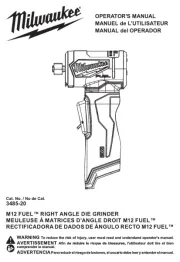
19 Augustus 2025
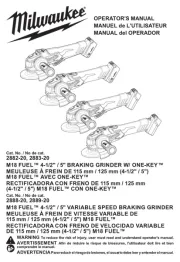
19 Augustus 2025
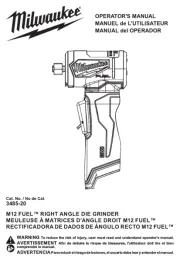
18 Augustus 2025
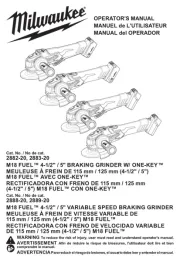
18 Augustus 2025
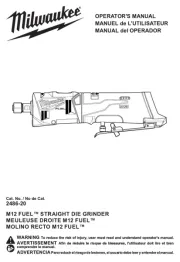
18 Augustus 2025
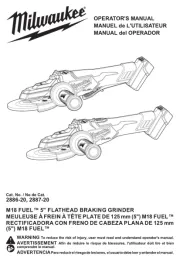
18 Augustus 2025
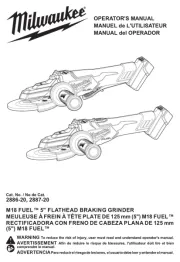
14 Juli 2025
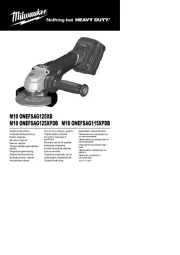
4 April 2025
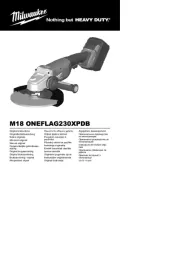
4 April 2025
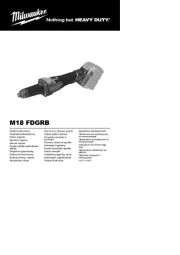
4 April 2025
Handleiding Slijpmachine
- Tanaka
- Cleco
- Makita
- Mac Tools
- Silvercrest
- Camry
- Dotco
- Draper
- Fieldmann
- Einhell
- Rikon
- Genesis
- Kress
- Hitachi
- Adler
Nieuwste handleidingen voor Slijpmachine
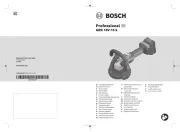
15 September 2025
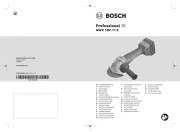
15 September 2025
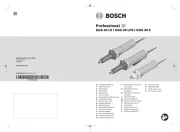
15 September 2025
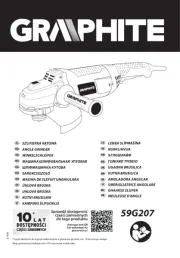
13 September 2025
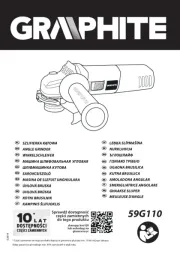
12 September 2025
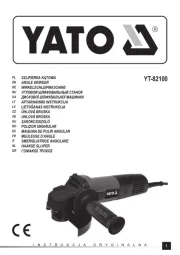
12 September 2025
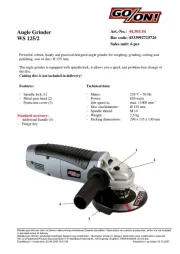
7 September 2025
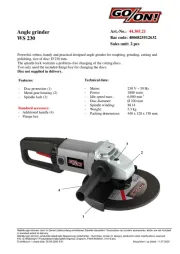
7 September 2025
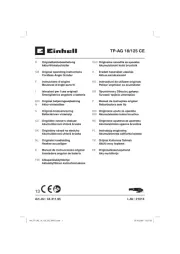
2 September 2025
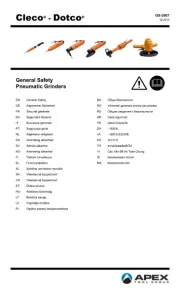
2 September 2025